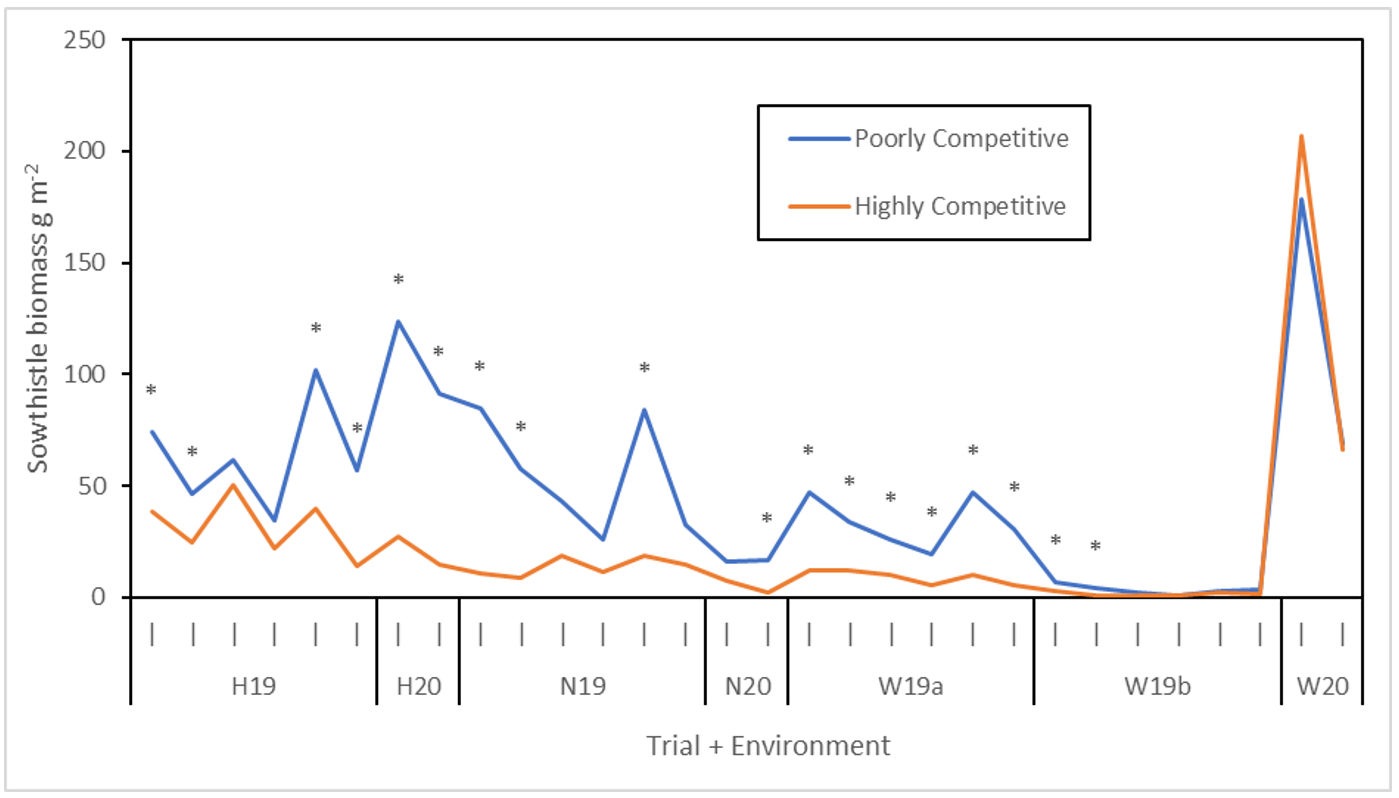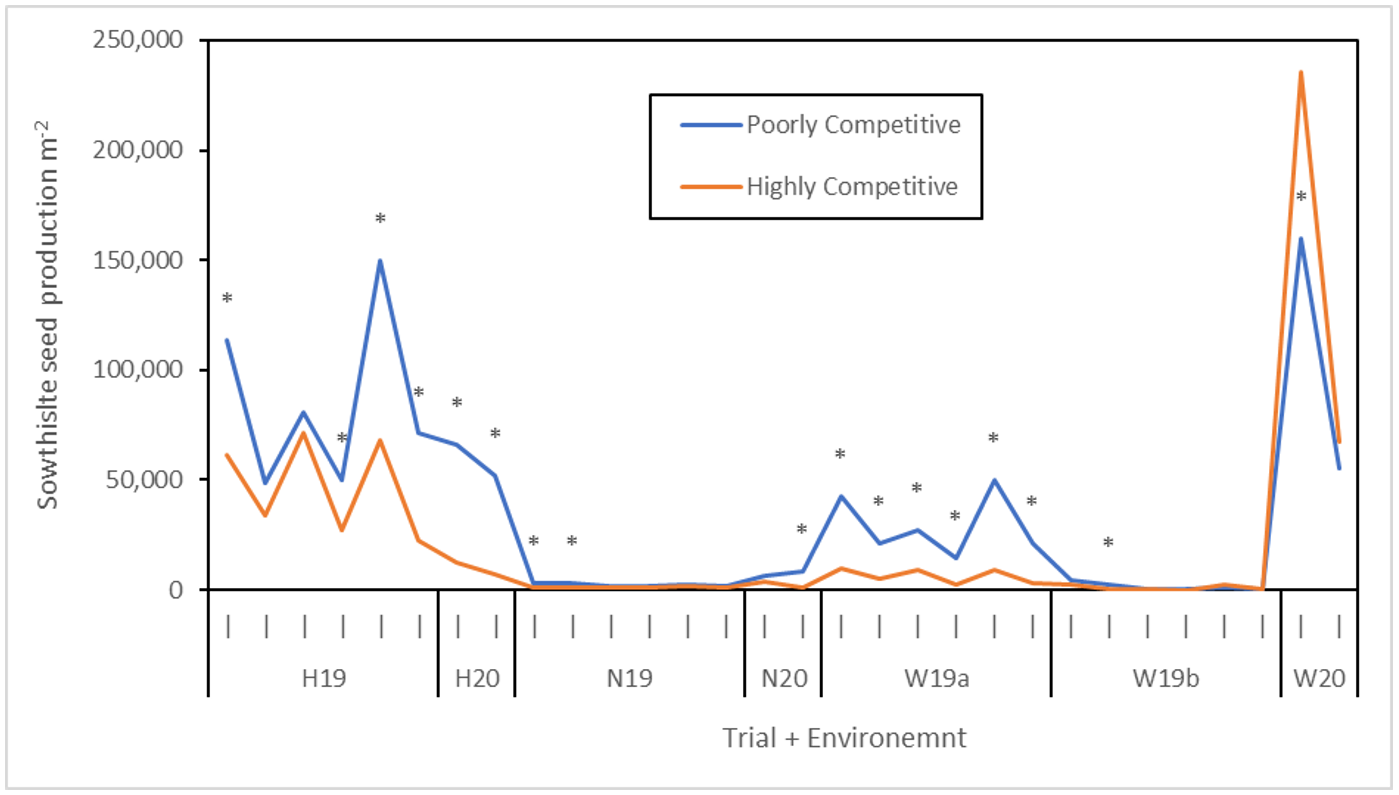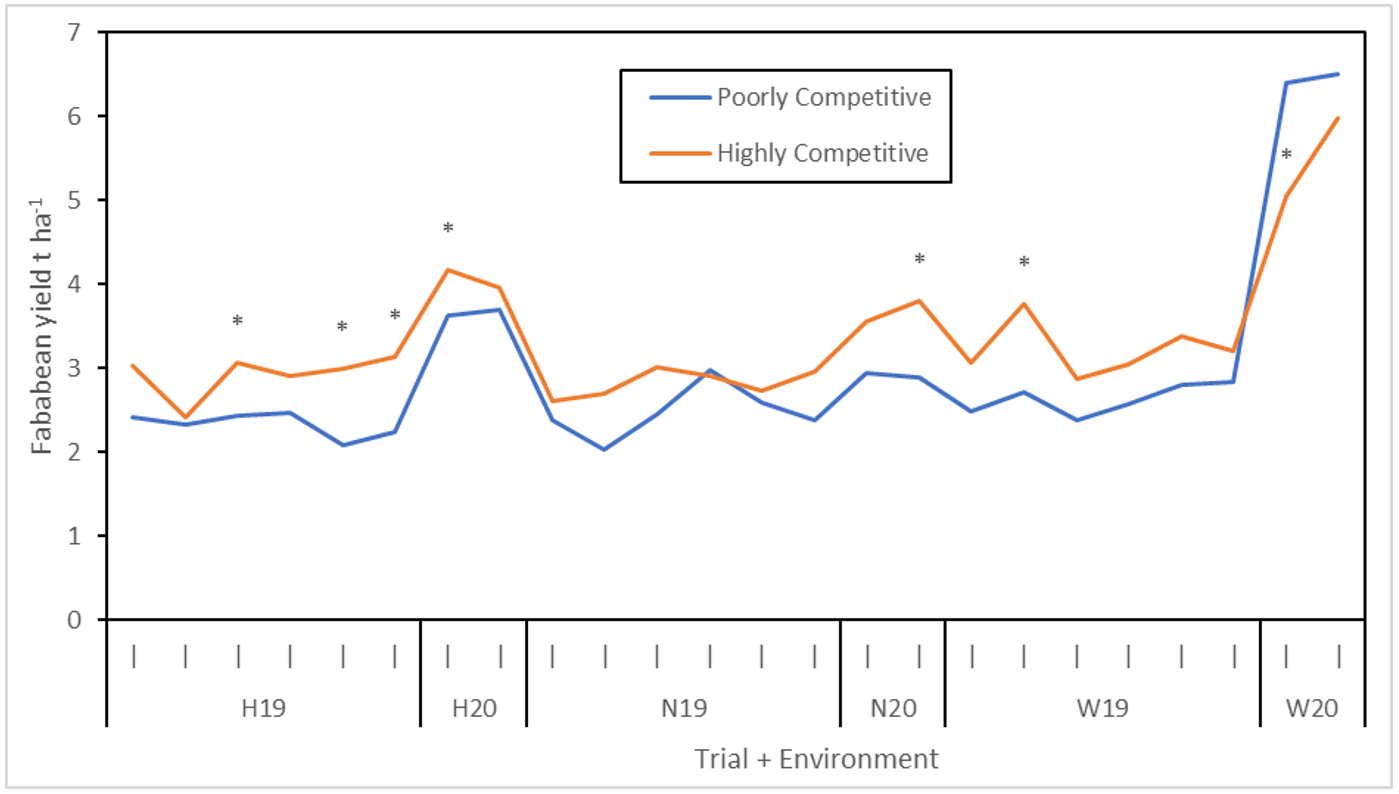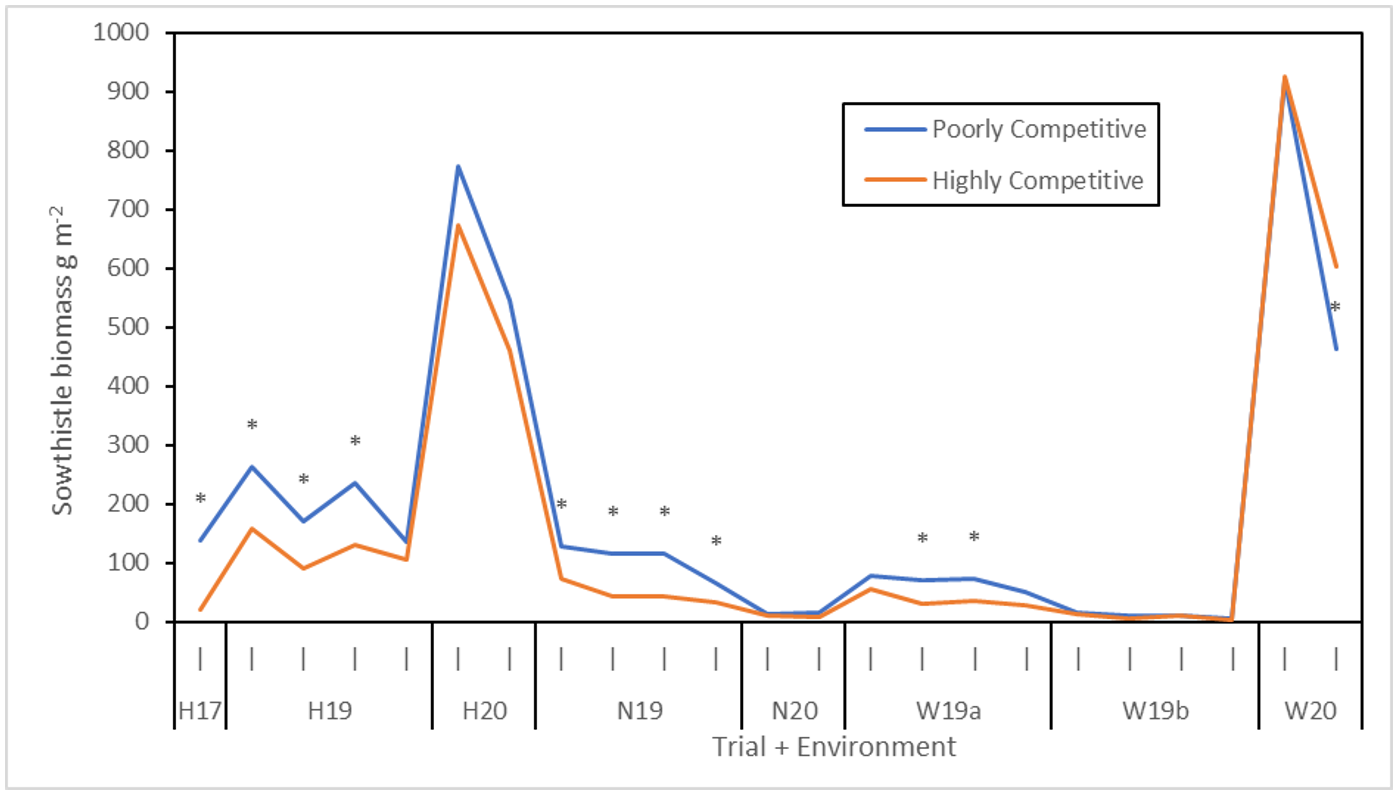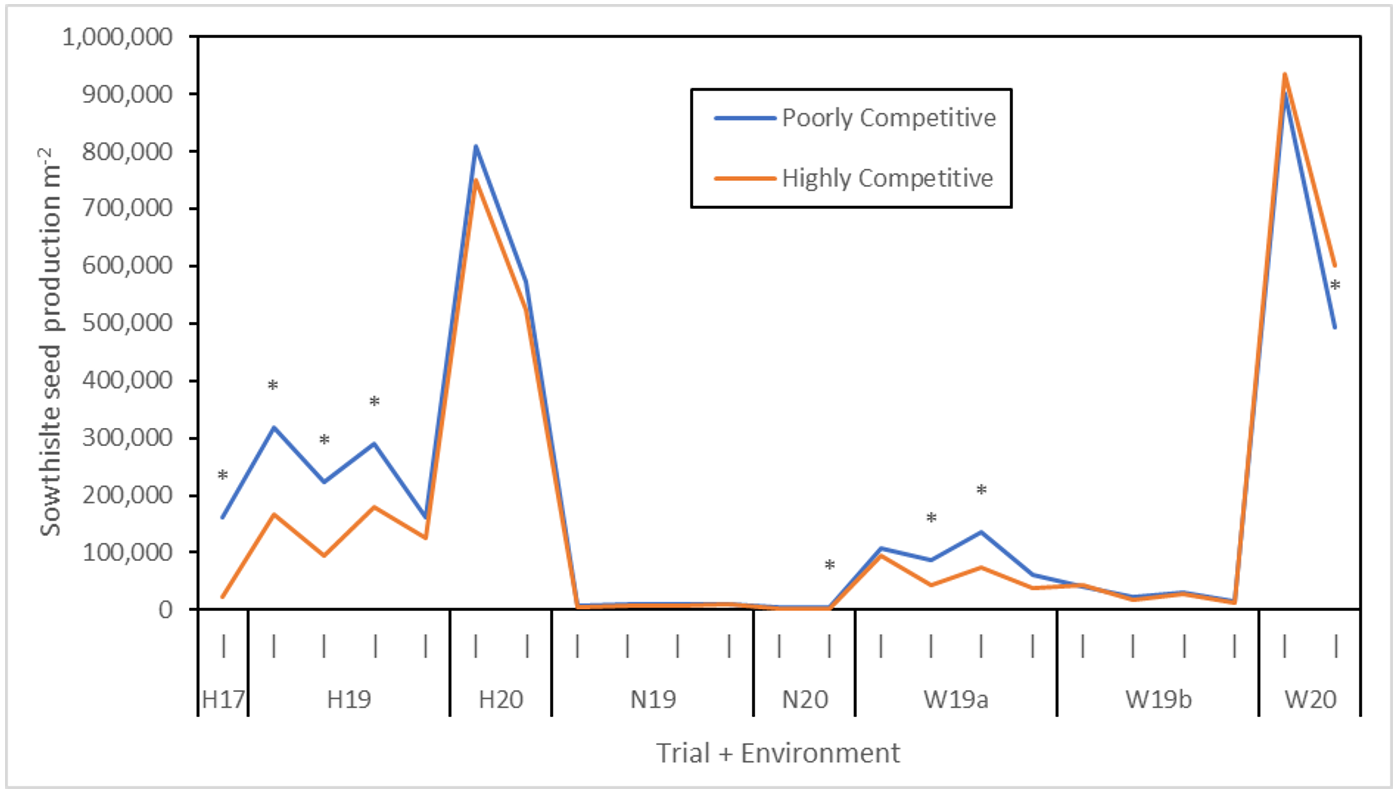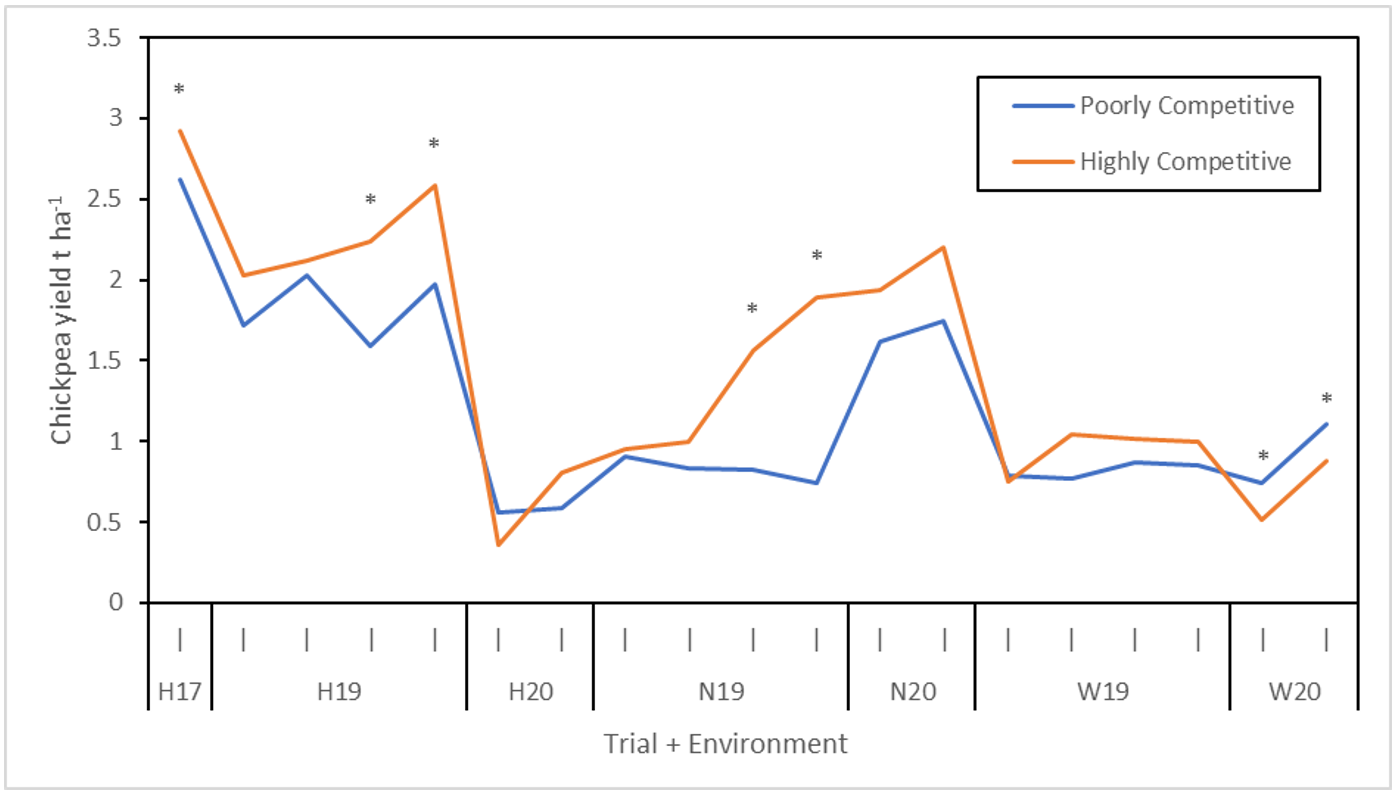Crop competition effects on weeds and crops – key trends from six years of research in the northern region
Crop competition effects on weeds and crops – key trends from six years of research in the northern region
Author: Michael Widderick (DAF Qld), Greg Harvey (DAF Qld), Hanwen Wu (NSW DPI), Asad Shabbir (NSW DPI), Kerry Bell (DAF Qld), Michael Walsh (University of Sydney) | Date: 28 Feb 2023
Take home message
- There is convincing evidence that increased faba bean or chickpea crop competition due to narrower row spacing (23 – 25cm row spacing) and/or increased crop density (30 plants/m2) reduces sowthistle growth and seed production
- Importantly in most instances, narrower row spacing and increased plant density of faba bean and chickpea crops did not have a negative impact on grain yields. In situations where resources (e.g. water) were not limiting, more competitive crops were often higher yielding
- The impact of different cultivars on sowthistle growth, sowthistle seed production and crop yield were not consistent for either faba bean or chickpea across trials and is likely a reflection of differences in cultivar adaptation to specific environments.
Background
In-crop weed control in the northern grain region (NGR) is heavily reliant on herbicides. However, this practice is not sustainable due to resistance. Herbicide resistance is becoming more common and is predicted to increase if there is an ongoing reliance on herbicides for weed control. To prevent further resistance, and for herbicides to remain an important tactic for weed control, a combination of chemical and non-chemical weed control tactics is required.
An often overlooked weed management strategy is the use of agronomic management for more competitive crops. Increased crop competition can be achieved by narrowing row spacing, increasing plant density or the use of more competitive crop species and cultivars. A competitive crop is able to compete against weeds to reduce weed growth (biomass) and seed production. While this general principle is commonly known, a 2015 review of data in Australia (Widderick et al 2018) revealed a lack of data for the key crop:weed combinations of the NGR.
As such, research was undertaken to quantify the effects of growing competitive crops for the following scenarios:
- Pulse crops (winter and summer),
- Sorghum, and
- Early emerging summer weeds in winter crops (wheat and chickpea)
This paper summarises results from the winter pulse (faba bean and chickpea) research conducted across 6 years and multiple sites and implications for growing competitive crops as a weed management tactic.
Methodology
Over the 2016 to 2021 winter growing seasons, replicated field trials were established across the NGR at three locations (Narrabri, Wagga Wagga and Hermitage) to provide data on crop competition across different seasons and sites. The impact of crop row spacing, crop density, cultivar and a combination of row spacing and crop density was measured on weed growth (biomass), weed seed production and crop yield.
At each site, common sowthistle were established either with the crop by sowing weed seeds, or by transplanting weeds into the crop. Exact crop and weed densities were established in fixed quadrats from which weed and crop measures were taken. To measure weed growth and seed production, destructive samples were taken. Crop yield was also measured at each trial. No herbicides were applied in the crops and background non-target weeds were manually removed.
For chickpea and faba bean, the row spacings compared were 23/25 cm and 46/50 cm (differences due to available planting equipment). For chickpea, the crop densities compared were 15 and 30 plants/m2, and for faba bean 20 and 30 plants/m2. Cultivar comparison for chickpea included PBA Boundary, Kyabra, PBA Seamer and PBA Slasher, and for faba bean PBA Warda, PBA Samira, PBA Nanu and PBA Marne.
The seasons encountered during the research ranged from severe drought to flooding. In drought seasons, supplementary irrigation was applied. In some cases, crop establishment and survival was greatly impacted by the season and any compromised data has been excluded from analyses.
The research produced a large quantity of data with a total of 49 winter crop trials. To establish key trends in data, a combined trial analysis across sites and seasons was undertaken. Separate analyses were done for each agronomic factor (i.e. row spacing, crop density and row spacing × crop density) and each crop. For these analyses, separate ‘environments’ were considered and compared. Within each year and location, an environment was where both levels of the crop agronomy were present. For example, when investigating narrow versus wide row spacing, trial H19 at Hermitage in 2019 included 12 environments (3 cultivars x 2 crop densities x 2 sowthistle densities). By pooling data in this way, we have been able to assess the impact of different agronomic factors (row spacing and/or crop density) over a range of different growing conditions.
When significant interactions between crop agronomy and environment occurred, a summary of pair-wise comparisons between the levels of crop agronomy practice (narrow vs wide row spacing, low vs high crop density, poor vs high competition) within each environment was undertaken using t-tests (i.e. a subset of least significant difference comparisons) to investigate trends in response to crop agronomy.
Results
Faba bean
A more competitive faba bean crop, due to narrower row spacing (23/25 cm) and/or increased crop density (30 plants/m2), consistently reduced sowthistle growth (biomass) and seed production, while maintaining grain yields in most cases. The greatest impact was evident when faba bean was grown at both a narrower row spacing and increased density where reduction in sowthistle growth and seed production were not only more frequent, but greater (Table 1). Our research showed an inconsistency in results relating to faba bean cultivar.
Table 1. Impacts of different agronomic factors in faba bean on sowthistle biomass, sowthistle seed production and faba bean yield.
Agronomic factors: Row spacing – Narrow = 23/25 cm vs Wide = 46/50 cm;
Crop density – Low = 20 vs High = 30 plants/m2; Row spacing × crop density – Poorly competitive = 50 cm + 20 plants/m2, Highly competitive = 25 cm + 30 plants/m2;
Cultivars – PBA Warda, PBA Nasma, PBA Samira, PBA Nanu and PBA Marne.
Agronomic factor | Sowthistle biomass | Sowthistle seed production | Faba bean yield |
|---|---|---|---|
Row spacing (55 to 68 environments from 9 to 11 trials) | Narrow row spacing reduced sowthistle biomass.
| Narrow row spacing reduced sowthistle seed production.
| Narrow row spacing resulted in a significant increase in faba bean yield.^ |
Crop density (36 to 48 environments from 3 or 4 trials) | High crop density reduced sowthistle biomass.
| High crop density reduced sowthistle seed production.
| Increased crop density resulted in a significant increase in faba bean yield.^ |
Row spacing × crop density (28 to 34 environments from 10 or 11 trials) | Highly competitive faba bean reduced sowthistle biomass (Figure 1).
| Highly competitive faba bean reduced sowthistle seed production (Figure 2).
| Highly competitive faba bean maintained or increased crop yield (Figure 3).
|
Cultivar | Inconclusive results, likely due to cultivar adaptation to different environments. | ||
* Includes both statistically significant and non-significant reductions.
^ Statistical main effect across environments.
Row spacing x crop density effect
Sowthistle biomass
Highly competitive faba bean, combining narrow row spacing (23/25 cm) with high crop density (30 plants/m2), resulted in a lower sowthistle biomass in all but one environment (Figure 1).
Figure 1. Impact of faba bean row spacing × crop density on sowthistle biomass production. Where Poorly competitive = 46/50 cm row spacing and 20 plants/m2, Highly competitive = 23/25 cm and 30 plants/m2, * = significant difference. The x-axis represents both the trial (location – H=Hermitage, N=Narrabri or W=Wagga Wagga) and year, and the ‘Environment’ represented by ‘I’ is a combination of faba bean cultivar and sowthistle density.
Sowthistle seed production
The seed production of sowthistle was reduced in a highly competitive faba bean crop (23/25 cm row spacing and 30 plants/m2) in all but three environments (Figure 2). For these three environments, the difference was significant in only one environment where production was high compared to other environments. At this site (W20) the 2020 growing season was favourable with the growing season rain (April to October) very close to the long-term average.
Faba bean yield
Growing faba bean at the highly competitive configuration of 23/25 cm row spacing and 30 plants/m2, either maintained or increased faba bean yield in all but three environments (Figure 3). For these three environments, this reduction in yield was significant for one environment where yield was high for both competition treatments compared to other environments.
Figure 2. Impact of faba bean row spacing × crop density on sowthistle seed production. Where Poorly competitive = 46/50 cm row spacing and 20 plants/m2, Highly competitive = 23/25 cm and 30 plants/m2, * = significant difference. The x-axis represents both the trial (location – H=Hermitage, N=Narrabri or W=Wagga Wagga) and year, and the ‘Environment’ represented by ‘I’ is a combination of faba bean cultivar and sowthistle density.
Figure 3. Impact of faba bean row spacing × crop density on faba bean yield. Where Poorly competitive = 46/50 cm row spacing and 20 plants/m2, Highly competitive = 23/25 cm and 30 plants/m2, * = significant difference. The x-axis represents both the trial (location – H=Hermitage, N=Narrabri or W=Wagga Wagga) and year, and the ‘Environment’ represented by ‘I’ is a combination of faba bean cultivar and sowthistle density.
Chickpea
A more competitive chickpea crop, due to a narrower row spacing (23/25 cm) resulted in a reduction in sowthistle biomass but had no effect on sowthistle seed production (Table 2). Chickpea grain yields were either maintained or increased at this narrower row spacing. An increased chickpea density from 15 to 30 plants/m2, resulted in a reduction in sowthistle growth (biomass) and seed production and an overall increase in chickpea yield. When narrow row spacing and increased crop density were combined, sowthistle biomass and seed production were reduced to a greater degree than either alone, and yield was maintained in most cases. Our research showed an inconsistency in results relating to chickpea cultivar.
Table 2. Impacts of different agronomic factors in chickpea on sowthistle biomass, sowthistle seed production and chickpea yield.
Agronomic factors: Row spacing – Narrow = 23/25 cm vs Wide = 46/50 cm;
Crop density – Low = 15 vs High = 30 plants/m2; Row spacing × crop density – Poorly competitive = 46/50 cm + 15 plants/m2, Highly competitive = 23/25 cm + 30 plants/m2;
Cultivars – PBA Boundry, Kyabra, PBA Slasher, and PBA Seamer.
Agronomic factor | Sowthistle biomass | Sowthistle seed production | Chickpea yield |
|---|---|---|---|
Row spacing (41 to 49 environments from 9 or 10 trials) | Narrow row spacing reduced sowthistle biomass.^ | No difference between narrow and wide row spacing across environments. | Yield maintained or increased with no evidence of yield reduction due to narrow row spacing.
|
Crop density (28 to 36 environments from 5 or 6 trials) | High crop density reduced sowthistle biomass.
| High crop density reduced sowthistle seed production.
| High crop density resulted in a significant increase in chickpea yield.^ |
Row spacing × crop density (19 to 23 environments from 7 or 8 trials) | Highly competitive crop reduced sowthistle biomass (Figure 4).
| Highly competitive crop reduced sowthistle seed production (Figure 5).
| Yield maintained or increased with little evidence of yield reduction due to a highly competitive crop (Figure 6).
|
Cultivar | Inconclusive results, likely due to cultivar adaptation to different environments. | ||
* Includes both statistically significant and non-significant reductions.
^ Statistical main effect across environments.
Row spacing x crop density effects
Sowthistle biomass
Highly competitive chickpea grown at 23/25 cm row spacing and density of 30 plants/m2, reduced the biomass of common sowthistle in all but one environment compared to chickpea grown at the wider row spacing of 50 cm and density of 15 plants/m2 (Figure 4). In this environment, the sowthistle biomass was large for both competition treatments compared to most other environments.
Figure 4. Impact of chickpea row spacing × crop density on sowthistle biomass production. Where Poorly competitive = 46/50 cm row spacing and 15 plants/m2, Highly competitive = 23/25 cm and 30 plants/m2, * = significant difference. The x-axis represents both the trial (location – H=Hermitage, N=Narrabri or W=Wagga Wagga) and year, and the ‘Environment’ represented by ‘I’ is a combination of chickpea cultivar and sowthistle density.
Sowthistle seed production
Competitive chickpea grown at a row spacing of 23/25 cm and a density of 30 plants/m2 reduced seed production of sowthistle in all but four environments (Figure 5). In only one of these environments was this difference significant and in this environment the sowthistle seed production was great in both competition treatments and generally greater than other environments.
Figure 5. Impact of chickpea row spacing × crop density on sowthistle seed production. Where Poorly competitive = 46/50 cm row spacing and 15 plants/m2, Highly competitive = 23/25 cm and 30 plants/m2, * = significant difference. The x-axis represents both the trial (location – H=Hermitage, N=Narrabri or W=Wagga Wagga) and year, and the ‘Environment’ represented by ‘I’ is a combination of chickpea cultivar and sowthistle density.
Chickpea yield
A competitive chickpea crop at a row spacing of 23/25 cm and a density of 30 plants/m2, maintained chickpea grain yield in most environments and increased grain yield in 5 environments (Figure 6). In contrast, in only 4 environments was there a decrease in crop yield in the highly competitive crop, and in only 2 of these environments was the yield reduction significant.
Figure 6. Impact of chickpea row spacing × crop density on chickpea yield. Where Poorly competitive = 46/50 cm row spacing and 15 plants/m2, Highly competitive = 23/25 cm and 30 plants/m2, * = significant difference. The x-axis represents both the trial (location – H=Hermitage, N=Narrabri or W=Wagga Wagga) and year, and the ‘Environment’ represented by ‘I’ is a combination of chickpea cultivar and sowthistle density.
Discussion
Growing a competitive faba bean or chickpea crop at a narrow row spacing (23/25 cm) and/or increased crop density (30 plants/m2) is likely to reduce in-crop growth (biomass) and seed production of common sowthistle. Favourably, these competitive crop configurations maintained crop yield in most environments, and in some environments resulted in significant yield gains. In a minority of environments, competitive crop configurations resulted in crop losses. A more competitive crop will require more resources (e.g. water) in order to retain or increase crop yield and grain quality.
Reducing sowthistle growth via a competitive crop takes the reliance off herbicides for in-crop weed control. In reality, herbicides (either pre- and/or post-emergence) will be applied in crop. A competitive crop will provide complimentary weed control and reduce the growth and seed production on any survivors of herbicide treatment, thus preventing weed spread and persistence. This is important for keeping weed densities low and also for preventing the spread of herbicide resistance, should these survivors possess resistance.
One of the barriers to adopting competitive crops is the required change in machinery, especially for narrow row spacing. Our research has shown an increased crop density, which doesn’t require machinery change, can provide competitive advantages against weeds that equal the effects of narrowing row spacing. However, combining a narrow row spacing with an increased crop density provided the greatest weed suppression advantages in our research.
To spread yield loss risk, grow competitive crops when resources are likely to be plentiful or only in select paddocks rather than the whole property. A competitive crop may be used as a replacement for in-crop herbicides if weed densities are low, or in a situation of high weed density, combining a competitive crop with pre- and post-emergence herbicide will minimise weed survival and seed production.
Our research has shown little consistency in effect of different faba bean and chickpea cultivars. This is not surprising given the adaptability of different cultivars to different growing environments. Although there may be weed control gains through cultivar selection, the gains achieved through narrow row spacing and increased crop density are likely to surpass those of changing cultivar.
Reference
Widderick M, Lemerle D, Taylor C, Johansen C, Hashem A, Osten V, Cook T, Bell K, Storrie A (2018). Research priorities for weed suppression by crops in Australia. In: Proceedings of 21st Australasian Weeds Conference, Sydney, NSW. Pp 133-136.
Acknowledgements
The research undertaken as part of this project is made possible by the significant contributions of growers through the support of the GRDC, the author would like to thank them for their continued support.
Contact details
Michael Widderick (Principal Research Scientist)
Queensland Department of Agriculture and Fisheries
Leslie Research Facility, Toowoomba
Ph: 07 4529 1325
Email: Michael.widderick@daf.qld.gov.au
Date published: March 2023
Varieties displaying this symbol beside them are protected under the Plant Breeders Rights Act 1994.
GRDC Project Code: UOS1703-002RTX,

